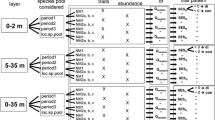Summary
Coefficients of interspecific association of three rotifer species (Brachionus calyciflorus, Brachionus rubens, Asplanchna brightuelli) of 314 plankton samples from about 100 ponds in South Germany were determined: two coefficients basing on present-absent data (Table 2: C 7, C 8), one coefficient regarding population density (Table 2: C 9), and one coefficient of partial interspecific association taking in mind the presence or absence of the third species (Table 3: C p). Some of the computed coefficients are significantly positive or negative indicating that joint appearances are sometimes more and sometimes less frequent than expected by chance. Most of these results cam be interpreted by the knowledge of interspecific relationships, vz. competition between Brachionus calyciflorus and B. rubens, and predator-prey relationships between Asplanchna brightwelli and B. rubens which had been detected in former studies. In each case the association between two of the species is modified by the presence of the third. The causes (alternative prey, destruction of the competitors etc.) are discussed.
Similar content being viewed by others
Literatur
Cole, L. C.: The measurement of interspecific association. Ecology 30, 411–424 (1949).
Cole, L. C.: The measurement of partial interspecific association. Ecology 38, 226–233 (1957).
Gilbert, N., Wells, T. C.: Analysis of quadrat data. J. Ecology 54, 675–685 (1966).
Halbach, U.: Das Zusammenwirken von Konkurrenz und Räuber-Beute-Beziehungen bei Rädertieren. Zool. Anz., Suppl. 33, 72–79 (1969a).
Halbach, U.: Räuber und ihre Beute: Der Anpassungswert von Dornen bei Rädertieren. Naturwissenschaften 56, 142–143 (1969 b).
Halbach, U.: Zum Adaptivwert der zyklomorphen Dornenbildung von Brachionus calyciflorus Pallas (Rotatoria). I. Räuber-Beute-Beziehungen in Kurzzeit-Versuchen. Oecologia (Berl.) 6, 267–288 (1971).
Hurlbert, H.: A coefficient of interspecific association. Ecology 50, 1–9 (1969).
Southwood, T. R. E.: Ecological methods. London: Methuen 1966.
Author information
Authors and Affiliations
Rights and permissions
About this article
Cite this article
Halbach, U. Assoziationskoeffizienten dreier planktischer Rotatorienarten im Freiland und ihre Deutung aufgrund interspezifischer Beziehungen (Konkurrenz, Räuber-Beute-Beziehung). Oecologia 9, 311–316 (1972). https://doi.org/10.1007/BF00345335
Received:
Issue Date:
DOI: https://doi.org/10.1007/BF00345335




